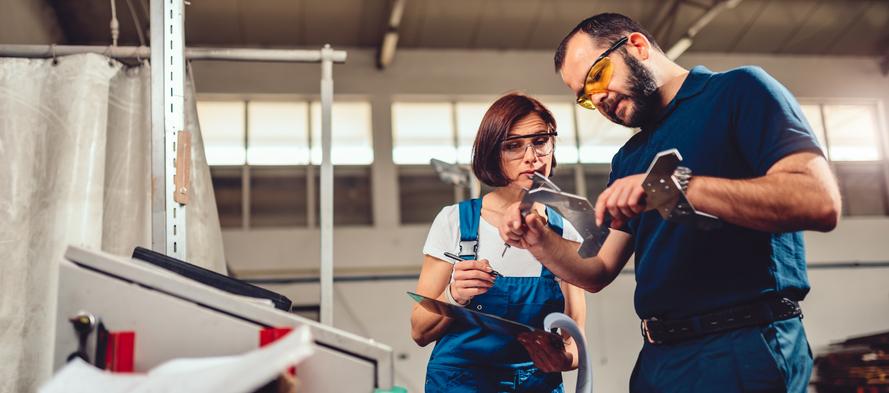Certified Welding Inspector
- FMA
- The Fabricator
- FABTECH
- Canadian Metalworking
Categories
- Additive Manufacturing
- Aluminum Welding
- Arc Welding
- Assembly and Joining
- Automation and Robotics
- Bending and Forming
- Consumables
- Cutting and Weld Prep
- Electric Vehicles
- En Español
- Finishing
- Hydroforming
- Laser Cutting
- Laser Welding
- Machining
- Manufacturing Software
- Materials Handling
- Metals/Materials
- Oxyfuel Cutting
- Plasma Cutting
- Power Tools
- Punching and Other Holemaking
- Roll Forming
- Safety
- Sawing
- Shearing
- Shop Management
- Testing and Measuring
- Tube and Pipe Fabrication
- Tube and Pipe Production
- Waterjet Cutting
Industry Directory
Webcasts
Podcasts
FAB 40
Advertise
Subscribe
Account Login
Search
Keep metal fabrication shop workers safe by prioritizing quality
Quality workmanship is key to developing a safe manufacturing environment
- By Glenn Weidman
- January 4, 2023
- Article
- Safety

By focusing on quality, a company can minimize the risk of injury to shop floor employees. Kerkez/iStock/Getty Images Plus
One of the biggest oversights in the trades today is the lack of focus on quality and the far-reaching implications that poor quality has on so many aspects of business. Quality is often sacrificed for the sake of production, but that can come with a cost—especially to personal safety.
The dictionary lists several definitions for quality, but the one most applicable to this discussion is “a degree of excellence.” In practical terms, it’s the ability of a product or service to perform its intended purpose for a reasonable interval of time. In fact, the International Standards Organization defines quality as “the totality of features and characteristics of a product or service that bear on its ability to satisfy stated or implied needs.”
The Quality/Safety Connection
A lack of commitment to quality can greatly increase the risk to workers’ safety. Let’s say you have produced a section of pipe that’s designed to connect a pipeline to a tank. If you build it too short or with a misaligned flange or a weld that fails to meet inspection requirements and needs rework/repair, what has happened to your exposure to the safety hazards associated with producing that pipe section? It has tripled! You produced the pipe the first time, then added two more steps—removing the defect and producing the pipe again, properly—and each of those extra steps has added the potential for a pinched finger, back strain, or a spark in the eye, among other dangers.
We need to stop focusing on safety as a stand-alone concept and consider the idea that safety and quality are interrelated—opposite sides of the same coin—and attention to both is part of a company’s safety culture.
Developing a true culture of safety in a shop takes more than rigidly enforced compliance measures. Administrative controls are needed, of course, and I am in no way dismissing the importance of an objective, comprehensive safety policy, but true safety goes far deeper than just telling people to put on a hard hat and protective glasses.
Picking the proverbial “low-hanging fruit” in a safety program is easy; it requires minimal knowledge, experience, skill, or ability to reprimand a worker for not wearing appropriate personal protective equipment. It takes a much higher standard of cognitive ability, knowledge, work, and experience to perform a qualitative assessment of a part that is being fabricated or an ongoing project of any size or scope.
Moving Beyond Compliance Enforcement
I remember a specific incident on a job site some 10 years ago. Two workers were attempting to assemble a prefabricated, field-goal-style bolt-up pipe support. As they were attempting to level the cross member that the pipe would rest on, one of the workers put his hand under the support to try to raise it into the level position. As he placed his hands under the support, his co-worker, on the opposite side of the pipe, decided to use a small, 4-lb. mini sledgehammer to beat the cross member into level. Suffice it to say, the worker put the full force of his swing into the first man’s hand, which crushed and nearly severed his right-hand index finger.
Because the assembly was part of a project building a well head and tank battery site for a high-profile energy company, a full-on investigation ensued with all the typical stand downs and impromptu safety meetings. Management and the energy company’s safety personnel made many valid points, as well as the requisite admonishments about the operators’ breakdown in communication and improper part handling. What was missing, however, was an inquiry into why the cross member was bound so tightly that it required so much force to be moved into the level position. Had anyone bothered to investigate further, as I did, they would have discovered that the tubing sleeve on the piece, designed to slide over the vertical post of the pipe support assembly, had been welded out of square and was bound up on the vertical support, impeding any further movement.
Sadly, a teachable moment was lost on a culture that never attempted to address safety policy with anything other than authoritarian compliance measures. Had the welder been more cautious and disciplined in his task, had a quality control inspector caught the out-of-square part, had the installers paid adequate attention to the parts they were charged with assembling—in other words, had quality been the top priority throughout the process—the cross member would not have been bound up on the vertical support and the blunt force trauma to the worker’s finger would have been avoided. (Thankfully, the worker healed properly with no long-term effects.)
Think back to the last safety-related incident within your own organization and ask yourself, honestly, if a lack of quality control somehow factored into the incident or was possibly the central cause.
Quality workmanship is key to developing a safe workplace, and safety is everyone’s responsibility. That means everyone needs to work together to ensure that they are producing products and services that will not require endless repairs and revisions that increase hazard exposure.
About the Author

Glenn Weidman
subscribe now

The Fabricator is North America's leading magazine for the metal forming and fabricating industry. The magazine delivers the news, technical articles, and case histories that enable fabricators to do their jobs more efficiently. The Fabricator has served the industry since 1970.
start your free subscription- Stay connected from anywhere

Easily access valuable industry resources now with full access to the digital edition of The Fabricator.

Easily access valuable industry resources now with full access to the digital edition of The Welder.

Easily access valuable industry resources now with full access to the digital edition of The Tube and Pipe Journal.
- Podcasting
- Podcast:
- The Fabricator Podcast
- Published:
- 04/16/2024
- Running Time:
- 63:29
In this episode of The Fabricator Podcast, Caleb Chamberlain, co-founder and CEO of OSH Cut, discusses his company’s...
- Trending Articles
Tips for creating sheet metal tubes with perforations

JM Steel triples capacity for solar energy projects at Pennsylvania facility

Are two heads better than one in fiber laser cutting?

Supporting the metal fabricating industry through FMA

Omco Solar opens second Alabama manufacturing facility

- Industry Events
16th Annual Safety Conference
- April 30 - May 1, 2024
- Elgin,
Pipe and Tube Conference
- May 21 - 22, 2024
- Omaha, NE
World-Class Roll Forming Workshop
- June 5 - 6, 2024
- Louisville, KY
Advanced Laser Application Workshop
- June 25 - 27, 2024
- Novi, MI


























